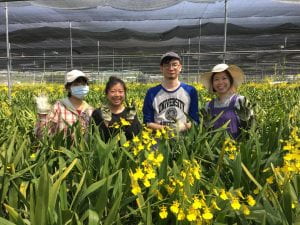It’s a beautiful, crisp February morning in Shigang, Taiwan, and a group of eight NUS students are hard at work on several pear farms and an orchid nursery dotted around the area. We’re working with members of the Shigang Mama Theatre, a company that began almost 20 years ago, following the horrific earthquake of 1999 that devastated various parts of Taiwan, particularly Shigang, a tiny district right along the fault line that runs through the heart of the island. Founded by a group of about a dozen Hakka women who are farmers, mothers and wives (and now grandmothers), their initial performances potently portrayed their traumatic experiences of the earthquake, then eventually incorporated other aspects of their lives as marginal, labouring women: their fears, their hopes, their dreams.
This field trip to Shigang is part of a long-term transnational project combining theatrical collaborations and academic research called A Home on the Island. This year’s workshop, the fourth in the series, was subtitled “Body, Labour and Gender.” Assistant Professor Liang Peilin, who teaches the module TS4222 Performance as Research in Applied Theatre, has worked with the Shigang Mama Theatre since the mid-2000s and has been bringing her students to the area to develop what she’s conceived of as a “probody aesthetics,” which is ”an endeavour that shifts the conceptualisation of theatre and performance from body-based or body-centered practices towards an idea of body-centric practices. This move is based on the idea of providing care for performers through their artistic practices and the artwork they make.” (Liang, 2018: 3, my emphasis)
Over the course of the two decades, the members of the Shigang Mama Theatre have begun to encounter physical injuries aggravated by age and the coercive demands of the agricultural labour they do on a daily basis. During our visit to Shigang from Feb 23 to 27 (2019), Dr Liang hoped that we might be able to start developing an approach to creating performances with the Mamas that might be restorative and therapeutic for their bodies, instead of physically exploitative. We also did work on their farms so that we could empathise with the strain on their bodies and the repetitive motions they are subject to. Over the course of the five days, and together with a Taiwanese chiropractor, Dr Hou Boyuan, we choreographed and devised short performance pieces incorporating various chiropractic movements that countered neck, shoulder, back, and knee injuries, aches and pains. These socially-engaged pieces also dealt with themes such as domestic responsibilities and challenges, agricultural labour, and marriage and parenthood.
My group was “adopted” by Yang Zhenzhen Mama, the leader of the Shigang Mama Theatre who is in her late 50s and runs a sprawling orchid nursery with her husband and son. We quickly found out how a probody aesthetics in performance has been helpful for her own body. During the harvest season, she often picks thousands of orchids a day – by hand, and without using any farming implements or tools that might damage the flowers. This caused her to develop excruciating pain on the right side of her neck, fingers and wrist, so much so that she could not even move her head. When Zhenzhen Mama picked up taiko drumming as part of the theatre company’s performer training she grew acutely aware of her non-dominant left hand. So she implemented a policy of ambidexterity on her farm, insisting that everyone on the farm had to be able to use both their dominant and non-dominant halves of their bodies to carry flower plots or pick flowers, and she believes it’s an ambidexterity that most flower farmers lack – even the most experienced farmers in the industry – and that has helped prevent more severe injuries.
A Home on the Island (IV): Body, Labour and Gender allowed us to learn how to devise performances that make use of a probody aesthetic that might be crucial to sustaining the bodies of the members of the Shigang Mama Theatre not just in their performance practices, but also in their everyday labour on their farms.
(Contributed by Corrie Tan.)


